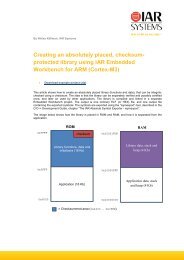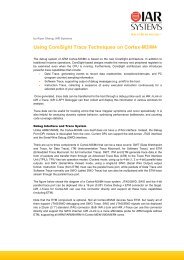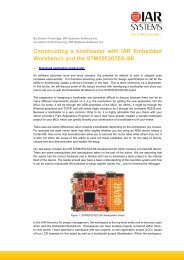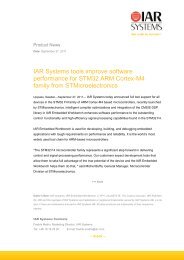C/C++ programming: Preprocessor directives in C - IAR Systems
C/C++ programming: Preprocessor directives in C - IAR Systems
C/C++ programming: Preprocessor directives in C - IAR Systems
Create successful ePaper yourself
Turn your PDF publications into a flip-book with our unique Google optimized e-Paper software.
y Hans Walheim, <strong>IAR</strong> <strong>Systems</strong><br />
<strong>Preprocessor</strong> <strong>directives</strong>: What became of my ??!<br />
Pitfalls and possibilities from compiler preprocess<strong>in</strong>g<br />
Code commented <strong>in</strong> your mother tongue occasionally leads to odd error messages from compilation.<br />
Two question marks and an exclamation ditto are replaced by one vertical bar.<br />
The seem<strong>in</strong>gly strange is easier to understand with an <strong>in</strong>sight <strong>in</strong> the translation phases of your compiler.<br />
The elements <strong>in</strong> the translation are def<strong>in</strong>ed <strong>in</strong> the C standard and are there to prepare the source code<br />
for the f<strong>in</strong>al code generation. This text is a brief guide to help<strong>in</strong>g you avoid problems and ga<strong>in</strong><br />
advantages from know<strong>in</strong>g a little bit more about the preprocess<strong>in</strong>g phases of translation.<br />
Translation accord<strong>in</strong>g to the C standard is divided<br />
<strong>in</strong>to 8 phases. The better known phases are<br />
perhaps phase 7 and 8 for pars<strong>in</strong>g, code<br />
generation, and l<strong>in</strong>k<strong>in</strong>g. Phases 1 through 6 are<br />
the preprocess<strong>in</strong>g phases.<br />
This text concentrates on the aspects of<br />
preprocess<strong>in</strong>g that are most important to software<br />
eng<strong>in</strong>eers to avoid an error or two <strong>in</strong> compilation,<br />
especially s<strong>in</strong>ce these errors tend to be most<br />
unexpected.<br />
The first phase of preprocess<strong>in</strong>g deals with<br />
trigraphs and may be the source of unexpected<br />
results dur<strong>in</strong>g compilation. Every trigraph is<br />
replaced by its correspond<strong>in</strong>g s<strong>in</strong>gle character,<br />
wherever the three trigraph characters are placed<br />
<strong>in</strong> the code. At this early stage of preprocess<strong>in</strong>g<br />
the code is treated merely as a great number of 8bit<br />
ASCII characters. A trigraph is replaced by the<br />
s<strong>in</strong>gle character <strong>in</strong>dependent of if placed <strong>in</strong> str<strong>in</strong>gs<br />
or comments.<br />
The translation phases<br />
1. Trigraph sequences are replaced by<br />
correspond<strong>in</strong>g characters.<br />
2. Backslash followed by newl<strong>in</strong>e<br />
character is deleted to splice l<strong>in</strong>es.<br />
3. Adjacent characters are jo<strong>in</strong>ed <strong>in</strong>to<br />
tokens separated by whitespace.<br />
Comments are replaced by one space<br />
characters.<br />
4. Preprocess<strong>in</strong>g <strong>directives</strong> are executed,<br />
macros are expanded and _Pragma<br />
operator expressions are executed.<br />
5. Character escape sequences are<br />
replaced.<br />
6. Str<strong>in</strong>g literals are concatenated.<br />
7. Each token (character sequence) from<br />
phase 3 is converted <strong>in</strong>to C-tokens.<br />
Source code is converted <strong>in</strong>to object<br />
code.<br />
8. Output from phase 7 is collected to<br />
form an executable.<br />
The C standard def<strong>in</strong>es n<strong>in</strong>e trigraphs. The one that most commonly causes problems is ??!. Str<strong>in</strong>gs<br />
and code comments aimed to be visible only to the software eng<strong>in</strong>eer and colleagues run the risk of<br />
<strong>in</strong>clud<strong>in</strong>g that sequence of characters as a part.<br />
pr<strong>in</strong>tf ("This should never happen ??! (?? LINE 47 ??)")<br />
When the above l<strong>in</strong>e of code is preprocessed it will look like this:<br />
pr<strong>in</strong>tf ("This should never happen | (?? LINE 47 ]")<br />
The example is perhaps irritat<strong>in</strong>g but not critical. The same replacement of characters <strong>in</strong> a str<strong>in</strong>g that are<br />
go<strong>in</strong>g to be displayed to an end customer us<strong>in</strong>g the product is another th<strong>in</strong>g.
Trigraph Correspond<strong>in</strong>g character<br />
??= #<br />
??( [<br />
??/ \<br />
??) ]<br />
??' ^<br />
??< {<br />
??! |<br />
??> }<br />
??- ~<br />
The table shows the n<strong>in</strong>e trigraphs and their respective correspond<strong>in</strong>g s<strong>in</strong>gle characters accord<strong>in</strong>g to the C standard.<br />
If you really need to use the character sequence ??! <strong>in</strong> your code, there are a couple of options. Either<br />
by “escap<strong>in</strong>g” the three character sequence (phase 5) or through str<strong>in</strong>g concatenation (phase 6). This is<br />
an illustration of escap<strong>in</strong>g:<br />
pr<strong>in</strong>tf ("What am I do<strong>in</strong>g \?\?!\n");<br />
It’s actually enough to escape only one of the question marks, like this:<br />
pr<strong>in</strong>tf ("What am I do<strong>in</strong>g ?\?!\n");<br />
The same l<strong>in</strong>e of code, now us<strong>in</strong>g str<strong>in</strong>g concatenation to avoid confusion with a trigraph dur<strong>in</strong>g<br />
preprocess<strong>in</strong>g:<br />
pr<strong>in</strong>tf ("What am I do<strong>in</strong>g ??""!\n");<br />
It’s quite common to write multi l<strong>in</strong>e macros us<strong>in</strong>g the backslash character \ as a l<strong>in</strong>e cont<strong>in</strong>uation mark.<br />
It makes the code more readable without break<strong>in</strong>g the s<strong>in</strong>gle l<strong>in</strong>e syntax of macros. Extensive macros<br />
are divided <strong>in</strong>to several l<strong>in</strong>es <strong>in</strong> the editor, every l<strong>in</strong>e end<strong>in</strong>g with the backslash character \ and a l<strong>in</strong>e<br />
break mak<strong>in</strong>g the code easier to read.<br />
This is how it might look:<br />
#def<strong>in</strong>e my_assert(arg) \<br />
((arg) ? \<br />
(void)0 \<br />
: \<br />
(void) handle_assert ( #arg,__FILE__, __LINE__ ) )<br />
The C standard supports this strategy. The backslash character and the l<strong>in</strong>e break are deleted from the<br />
code <strong>in</strong> phase 2 splic<strong>in</strong>g physical source l<strong>in</strong>es to logical ones.<br />
In relations to phase 2, a couple of characteristic problems can arise. A mistake on the computer<br />
keyboard places an <strong>in</strong>visible space character at the end of the l<strong>in</strong>e. The l<strong>in</strong>e break isn’t removed, leav<strong>in</strong>g<br />
the macro <strong>in</strong>correctly divided <strong>in</strong> two l<strong>in</strong>es.<br />
It might be tempt<strong>in</strong>g to use the space after the backslash for code comments, but that will not work. Only<br />
the sequence ‘backslash’, ‘new-l<strong>in</strong>e’ will do the splic<strong>in</strong>g so any comments must come before the<br />
backslash.<br />
In phase 3, code comments are deleted and replaced by a s<strong>in</strong>gle space character. There isn’t a great<br />
deal to say about that. Phase 4 is more <strong>in</strong>terest<strong>in</strong>g. Preprocess<strong>in</strong>g <strong>directives</strong> are executed and macro<br />
<strong>in</strong>vocations are expanded. Once executed and expanded no reiteration is performed, which one may be<br />
lead to believe. Thus none of the <strong>in</strong>tentions revealed <strong>in</strong> the follow<strong>in</strong>g examples are fruitful.<br />
Page 2
First example:<br />
#def<strong>in</strong>e MY_ASSERT_NG1 #<strong>in</strong>clude "my_assert.h"<br />
MY_ASSERT_NG1<br />
Second example:<br />
#def<strong>in</strong>e NO_OPT_NG #pragma optimize=none<br />
Third example:<br />
#def<strong>in</strong>e MY_ASSERT_NG2 my_assert.h<br />
#<strong>in</strong>clude "MY_ASSERT_NG2"<br />
The ANSI committee has realized that there is a po<strong>in</strong>t to the <strong>in</strong>tentions <strong>in</strong> the first and third example, so<br />
the committee has <strong>in</strong>troduced the syntax #<strong>in</strong>clude pp-tokens. The problems above (the first and third<br />
example) are circumvented us<strong>in</strong>g this syntax <strong>in</strong> these l<strong>in</strong>es of code:<br />
#def<strong>in</strong>e MY_ASSERT_OK "my_assert.h"<br />
#<strong>in</strong>clude MY_ASSERT_OK<br />
#if #endif #error<br />
#ifdef #<strong>in</strong>clude #pragma<br />
#ifndef #def<strong>in</strong>e #<br />
#else #undef<br />
#elif #l<strong>in</strong>e<br />
Preprocess<strong>in</strong>g <strong>directives</strong> executed <strong>in</strong> phase 4.<br />
The comb<strong>in</strong>ation of the two preprocess<strong>in</strong>g <strong>directives</strong> #def<strong>in</strong>e and #pragma is worth discuss<strong>in</strong>g a bit<br />
more. Let’s say it’s desirable to be able to use two compilers on a s<strong>in</strong>gle source code file. Such a desire<br />
is seen <strong>in</strong> this approach.<br />
#ifdef <strong>IAR</strong><br />
#def<strong>in</strong>e NO_OPT #pragma optimize=none<br />
#else<br />
#def<strong>in</strong>e NO_OPT #pragma …<br />
#endif<br />
When preprocess<strong>in</strong>g <strong>directives</strong> have been executed and macros expanded, #pragma will rema<strong>in</strong> but<br />
without hope for a possibility of ever be<strong>in</strong>g executed by the preprocessor because phase 4 is already left<br />
for phase 5. This desire fortunately is possible to meet <strong>in</strong> another way. The C standard has addressed<br />
the issue through the <strong>in</strong>troduction of the keyword _Pragma. The _Pragma keyword is supported <strong>in</strong> <strong>IAR</strong><br />
compilers.<br />
So from the example above, what you can do is:<br />
#ifdef <strong>IAR</strong><br />
#def<strong>in</strong>e NO_OPT _Pragma ("optimize=none")<br />
#else<br />
#def<strong>in</strong>e NO_OPT _Pragma ("…")<br />
#endif<br />
NO_OPT<br />
void some_func(void)<br />
{<br />
…<br />
}<br />
Until now the focus has been on pitfalls only. Phase 5 conta<strong>in</strong>s a couple of possibilities. Bear with me.<br />
Page 3
In phase 5 you have the ‘escap<strong>in</strong>g’ of character constants, e.g. :<br />
\' the character '<br />
\" the character "<br />
\? the character ?<br />
\\ the character \<br />
\x hexadecimal character<br />
Embedded applications need to be able to display written languages us<strong>in</strong>g for <strong>in</strong>stance Arabic or<br />
Ch<strong>in</strong>ese letters to the user of the product. A typical application uses a driver to <strong>in</strong>terpret Unicode str<strong>in</strong>gs<br />
and display the correspond<strong>in</strong>g character. Editors support<strong>in</strong>g Unicode are used for writ<strong>in</strong>g the C code.<br />
Compilation of such an application may run <strong>in</strong>to problems s<strong>in</strong>ce the C standard only supports 8-bit<br />
ASCII characters. Without corrective actions the Unicode str<strong>in</strong>gs are divided <strong>in</strong>to irrelevant ASCII<br />
characters. Quotation marks around the str<strong>in</strong>gs partly solve this problem to keep the str<strong>in</strong>g unaltered<br />
through to phase 5. But, to be honest, it’s also a matter of luck s<strong>in</strong>ce the compiler is always read<strong>in</strong>g the<br />
source as 8-bit ASCII characters. There will always be a risk <strong>in</strong>volved <strong>in</strong> us<strong>in</strong>g non-ASCII code <strong>in</strong> the<br />
source.<br />
Let’s look at another example to show you what I mean. The picture shows the Japanese word for<br />
“ability”.<br />
The S-JIS editor code for this Japanese word is 945C. The code conta<strong>in</strong>s 0x5C, which represents<br />
backslash and runs the risk of be<strong>in</strong>g the last character on a l<strong>in</strong>e of code lead<strong>in</strong>g to l<strong>in</strong>e splic<strong>in</strong>g (phase<br />
2). If used <strong>in</strong>side e.g. a str<strong>in</strong>g this 0x5C will try to escape the next character (phase 5) possibly lead<strong>in</strong>g<br />
to some error, but <strong>in</strong> any circumstances the S-JIS <strong>in</strong>terpretation will have disappeared.<br />
Us<strong>in</strong>g non-ASCII characters, for example <strong>in</strong> a Unicode str<strong>in</strong>g, can be done as shown <strong>in</strong> the example to<br />
avoid mix-ups <strong>in</strong> any of the preprocess<strong>in</strong>g phases.<br />
char str[] = "\x84\xFF"<br />
\x <strong>in</strong> the str<strong>in</strong>g implies that the follow<strong>in</strong>g number is hexadecimal, 84 and FF respectively <strong>in</strong> this case and<br />
the characters will be left unchanged for sure.<br />
Str<strong>in</strong>g values can be problematic even if Unicode isn’t used. Applications that for some reason need the<br />
byte sequence 0x0D,0x0A <strong>in</strong> for example a str<strong>in</strong>g will suffer from a mis<strong>in</strong>terpretation dur<strong>in</strong>g phase 2<br />
s<strong>in</strong>ce the sequence of "0D0A" represents a l<strong>in</strong>e break. \x is the solution to this problem as well.<br />
"\x0D\x0A" will pass phase 2 as <strong>in</strong>tended.<br />
In phase 6 adjacent str<strong>in</strong>g literals are concatenated. This supports the possibility to make the source<br />
code easier to read <strong>in</strong> the editor. This example shows how it’s done.<br />
char usage[] =<br />
"Usage:\n" /* Can comment here, phase 3 has already */<br />
" MyApp [options] <strong>in</strong>file outfile\n"<br />
/* made the comments <strong>in</strong>to one space */<br />
" Options:\n"<br />
" -a all\n"<br />
" -b bald\n"<br />
" -c cold\n";<br />
The source code is f<strong>in</strong>ally prepared for pars<strong>in</strong>g, code generation, and l<strong>in</strong>k<strong>in</strong>g. Hopefully, the knowledge<br />
from this article will limit the number of error messages or at least help you f<strong>in</strong>d out what is go<strong>in</strong>g on<br />
beh<strong>in</strong>d the scene when you get confus<strong>in</strong>g error messages from the compiler. The text has been limited<br />
Page 4
to describ<strong>in</strong>g elements from the preprocess<strong>in</strong>g phases that are regarded relevant to software eng<strong>in</strong>eers<br />
to avoid a selection of typical errors. The complete C standard documentation is recommended for more<br />
<strong>in</strong>formation and details about the translation phases.<br />
Page 5











